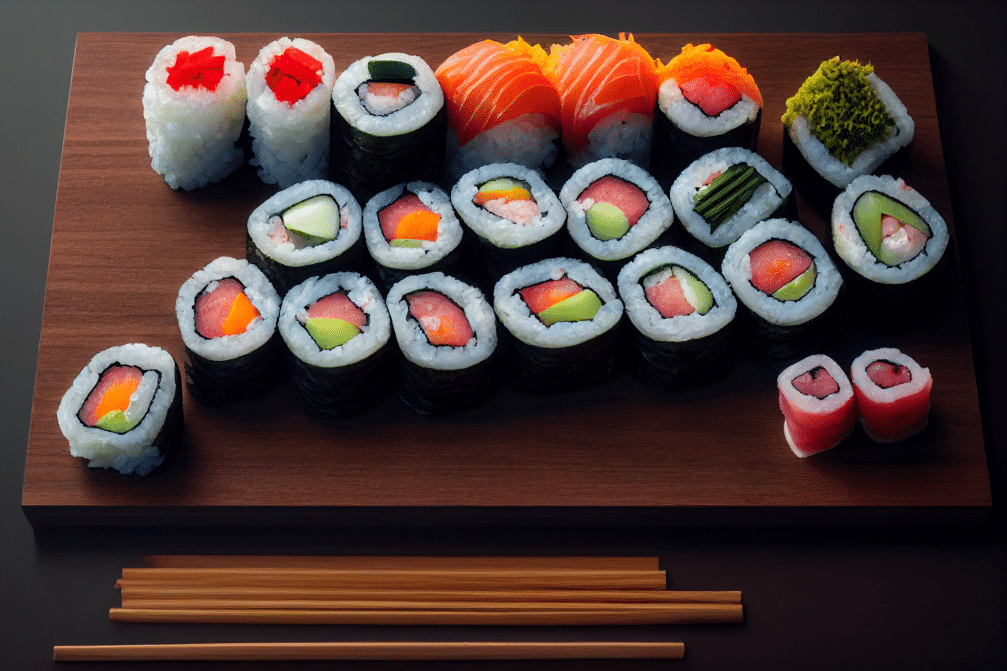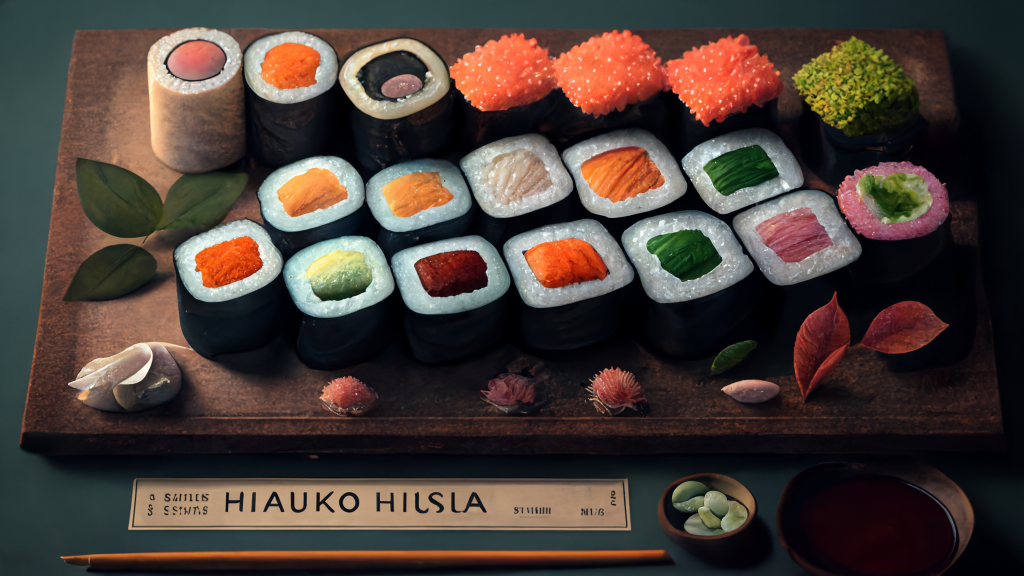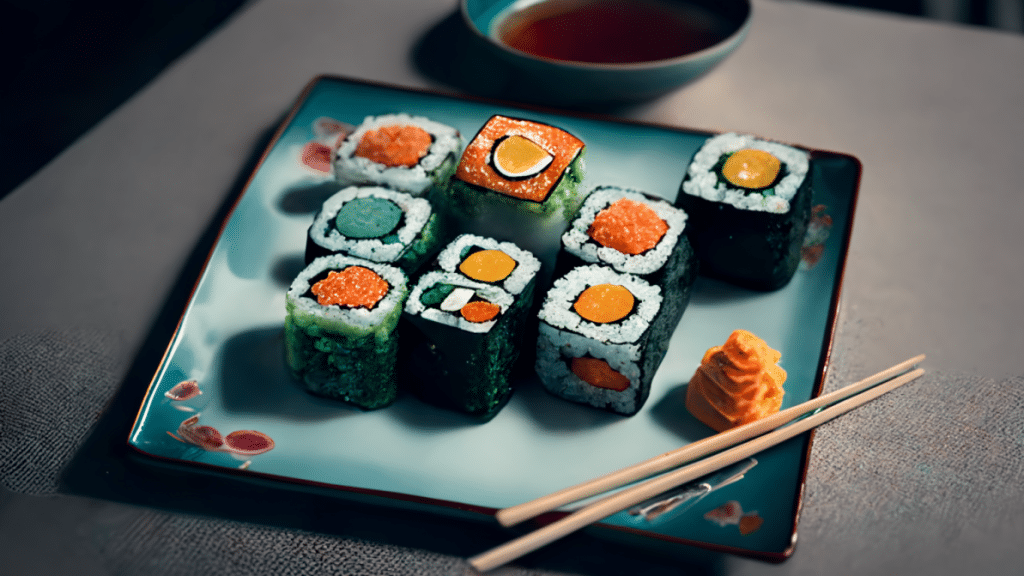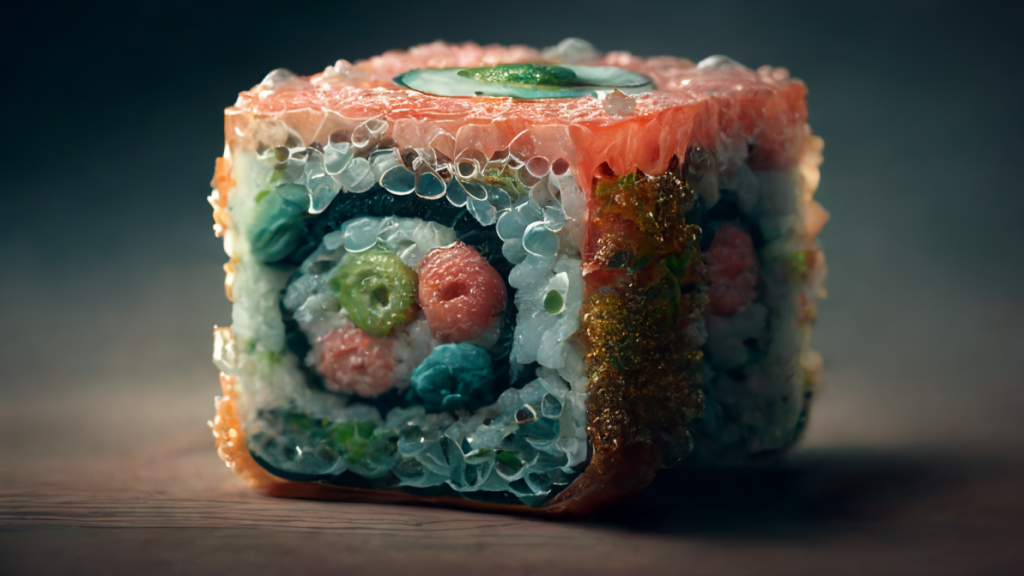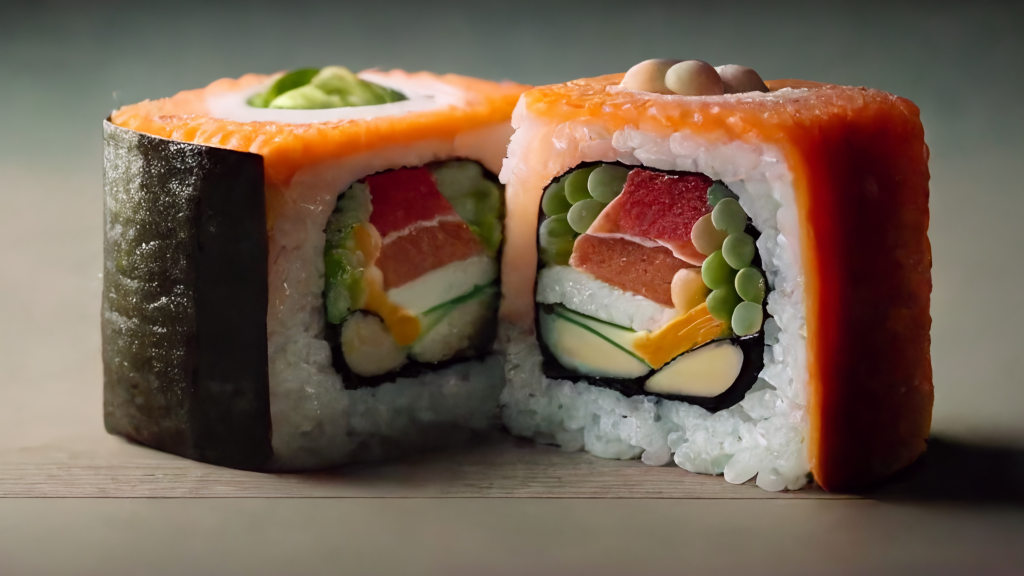If you’re someone who loves food but hasn’t traveled much, here’s a delicious, classic Japanese food that you need to try! We’re talking about Maki Sushi. This delicious, highly popular sushi roll dates back centuries, and its popularity has only grown in recent years. So, if you’re ready to expand your culinary palette, let’s take a look at what Maki Sushi is and how it’s made. Maki Sushi has a distinctive look, with its nori (seaweed) exterior and its melt-in-your-mouth, maki-filled interior. The secret to Maki Sushi lies in its preparation method; the ingredients are carefully rolled, leaving the nori on the outside and the rice and maki fillings on the inside. This perfectly-rolled combination is not only aesthetically pleasing, but it captures the flavor of the maki perfectly. So, when you bite into a Maki Sushi roll, you’re getting the flavors of the nori, the maki, and the rice, all in one bite.Trust us, Maki Sushi is a great way to sample some classic Japanese cuisine!
Table of Contents
Quick Response to Key Question
Maki sushi is a type of Japanese sushi roll, made with vinegared rice and various fillings, such as vegetables, fish or seafood, wrapped in nori (dried seaweed). They can be served either inside-out or outside-in, with the filling ingredients visible on the outside.
What is Maki Sushi?
Maki sushi, also known as rolled sushi, is a Japanese food dish consisting of seaweed (nori) wrapped around vinegared rice, vegetables, and sometimes raw fish. This type of sushi is usually served in slices and enjoyed with soy sauce or wasabi. In fact, maki sushi has become an increasingly popular dish all over the world because of its delicious yet healthy qualities. When it comes to the debate about what maki sushi is, there are some that say it’s simply a combination of cucumber and avocado rolled together in bacon. However, purists will argue that it’s so much more than just that; It’s a unique combination of many flavors in one bite—a harmony of proteins, textures, spices, fruits and veggies all wrapped in nori or seaweed.
No matter which side you take up in the argument, what remains clear is that maki sushi is at once delectable and versatile enough to accommodate any palate. With this in mind, let’s dive into the different ingredients and types of maki sushi available so you can choose the perfect roll for your next meal! With the many options available to you now that you know the basics of what maki sushi is and how to make it at home or find it on restaurant menus, let’s review the various ingredients and types of maki sushi available as we move onto our next section.
●Maki sushi is believed to have originated in Japan during the Edo period (1603 – 1868) as a convenient way to transport food.
●Maki sushi typically consists of vinegared rice, seafood, vegetables, and nori seaweed, although there are many variations popular today.
●According to UNESCO, maki sushi has been recognized as an official intangible cultural heritage of Japan since 2013.
Ingredients & Types of Maki Sushi
Maki sushi, also referred to as “rolled sushi”, is a type of Japanese dish made with vinegared sushi rice and various fillings. This form of sushi consists of rice and other ingredients wrapped up in nori (dried seaweed) paper using a makisu (bamboo mat). These rolls can vary in size and come in different forms such as hosomaki (thin roll), futomaki (thick roll), temakizushi (hand-rolled cone shape), and uramaki (inside-out roll). The most common ingredients used to make maki sushi are boiled white-colored short grain rice, sashimi or cooked fish, vegetables, nori seaweed, and tsukemono (pickled goods). Many people debate whether or not avocado is a traditional ingredient for maki sushi. Some say that since avocadoes became widely available in Japan during the 1960s, they are considered a modern addition. On the other hand, others argue that avocados have been incorporated into many kinds of Japanese cuisine long before the 1960s. Ingredient selection for maki sushi is quite versatile and can be tailored to individual preferences. Some popular options include crab meat and cucumber; salmon and cream cheese; tuna, mayonnaise and scallion; avocado, cucumber, and feta cheese; tempura shrimp; spicy tuna; and so on. Whatever combination you choose with along with food presentation will make for an eye-catching result.
When making maki sushi at home, it’s important to use high quality ingredients and prepare them properly. Always buy the freshest cuts of fish from your local market and ensure all vegetables are cut evenly. Furthermore, lay nori seaweed out flat before folding it sides over and always use warm water to moisten fingers while packing the rolls. Now that you know what ingredients go into maki sushi let’s move on to discuss another important factor – the nori seaweed.
Nori Seaweed
When it comes to maki sushi, nori seaweed is a key ingredient. Nori is an edible type of algae, harvested from the sea. It contains a variety of nutrients, including iron and protein, making it an essential part of any balanced diet. In addition to its nutritional value, nori has a unique flavor and texture that makes it an excellent choice for the sushi experience. The debate around nori centers on its harvesting methods. While this type of algae can be grown in controlled environments, such as farms or open ocean enclosures, wild-caught nori has become increasingly popular among sushi lovers all over the world. Some experts argue that wild-caught nori can offer a richer flavor than farmed varieties due to its natural environment. However, there are concerns about the environmental costs associated with harvesting from the sea due to potential overfishing. No matter how it’s sourced, nori seaweed remains an essential part of the maki sushi experience.
Its great taste and nutrition have made it a favorite among chefs and diners alike. From thinly sliced sheets to shredded flakes and more, nori provides the perfect wrapper to tie together the ingredients of a delicious roll. With its unique flavor and nutritional content, nori serves as an important building block in creating delicious maki sushi rolls. The next section will discuss another essential ingredient: sticky rice!
Sticky Rice
Sticky rice, also known as sushi rice or Japanese short-grain rice, is essential to making maki sushi. This type of rice is unique because it has higher levels of starch, making it stick together when cooked. Sticky rice also absorbs other flavors easily, thus giving maki sushi its distinct taste. When preparing the sticky rice for maki sushi, it is important to rinse the grains thoroughly with cold water and then strain the water off. The grains should then be cooked with an even amount of water. Once cooked, a simple vinegar mixture is used to season the sticky rice.
This mixture typically includes sugar and salt, but recipes may differ from region to region or from chef to chef. Once the sticky rice is prepared and seasoned, it can then be formed into an appropriate shape for rolling. Some people believe that the temperature of the sticky rice should be lukewarm for easier manipulation when rolling, while others suggest that the rice should be cooled before use. Each approach has its advantages and drawbacks; there is no right answer as to which technique produces better results. Leading into the next section: The combination of sticky rice, fish and vegetables are what make up a complete maki sushi roll. Next up, let’s take a look at how these components are selected and prepared for a maki sushi dish.
Fish & Vegetables
Fish and vegetables are popular ingredients for maki sushi, giving the dish a unique, flavorful combination of tastes and nutritional benefits. Depending on the type of fish, the final maki sushi rolls may be delicious and fattening, or lean and healthy. Many seafood choices, such as smoked salmon and tuna, can be used to make maki sushi. Seafood is packed with protein and omega-3 fatty acids that help promote heart health. It is also rich in other nutrients such as zinc, iron, magnesium, and selenium. A variety of vegetables such as avocados, cucumbers, lettuce and carrots makes up the bulk of maki sushi filling. Vegetables provide an array of vitamins and minerals that support digestive health and overall wellbeing.
Debates exist when it comes to the optimal choice of filling for maki sushi based on whether calories, taste or greater variety should be prioritized. Those who prefer taste may opt for heavier meats like beef or chicken in lieu of fish and vegetables. The calorie count would be higher but offer a more dynamic flavor palette to enjoy. On the other hand, those who prioritize their daily calories may opt for more vegetable fillings than meat components to their maki sushi rolls. A prudent balance between both camps will give you the best combination of nutrition and taste in your rolls. No matter your preference for these two mainstays of maki sushi filling, the next section will discuss traditional and popular combinations that have become go-to favorites around the world. This section will explore what combinations have proven popular based on regional cuisines; this could lead to a great opportunity to find interesting new flavors within your local neighborhood restaurant or even abroad!
Traditional & Popular Filling
Traditional and popular fillings for maki sushi range from raw fish to cooked proteins like beef, chicken, and pork. For traditional maki sushi, the preference generally leans toward raw fish, especially salmon, tuna, or yellowtail. With the growing popularity of sushi in recent decades, more filling options have become available; so while it is still common to find maki sushi featuring raw fish as the main protein source, cooked proteins can be considered just as popular. One benefit to using raw fish within maki sushi is that it allows for flavors to remain undiluted when compared with cooked proteins. This often leads to a cleaner flavor profile in which the subtle nuances of each ingredient are allowed to shine through each bite.
On the flip side, some people often enjoy the deeper umami flavors provided by cooked proteins and sauces accompanying them. Depending on personal tastes and preferences, either raw or cooked ingredients can be used within maki sushi. Overall, traditional and popular fillings for maki sushi range from raw and cooked proteins such as fish, shellfish, beef, pork, and chicken with sauces to accentuate flavors as desired. It should be noted that since some raw ingredients carry a risk of food borne illnesses, certain precautions must be taken when handling them at home and purchasing them from trusted establishments when dining out. Regardless of whether one opts for raw or cooked proteins in their maki sushi roll-ups, having a wide variety of filling options opens up countless possibilities when preparing these delicious treats. With this in mind, let’s now look at vegetarian fillings that provide an alternative option for those who abstain from meats and poultry.
Crucial Highlights
Maki Sushi is a popular Japanese dish typically consisting of a variety of raw and cooked proteins, seafood and sauces. Traditional ingredients include raw fish such as salmon, tuna and yellowtail, as well as cooked proteins like beef, chicken and pork; however, recent popularity has seen the emergence of additional fillings and sauces. Raw fish provides clean flavours while cooked proteins provide deeper umami notes. Vegetarian options are also available for those who abstain from meats and poultry.
Vegetarian Fillings
Vegetarian fillings are a popular option when it comes to sushi, and the options are practically endless. Vegetables can be added to rolls, such as grated carrots, cucumbers, cabbage, and bell peppers. Avocado is another popular topping for sushi rolls due to its abundance of healthy fats. Entirely vegetarian rolls can also be created with the help of tofu and tempeh. Mushrooms, asparagus, sweet potatoes, and edamame are all delicious vegetarian ingredients that can be used to fill sushi rolls. Some people argue that the traditional foods which make up maki sushi must include fish or seafood in order to be true to the spirit of Japanese gastronomy, while others believe that vegetarian maki sushi is a more modern development that suits certain dietary requirements and still tastes delicious. Popular sauces are often what give sushi their unique flavorings and help bring out the individual flavors in each ingredient. The next section will explore some of the most common sauces used in maki roll dishes.
Popular Sauces
Sushi and its many varieties are loved far and wide around the world, one of these being maki sushi. As with many dishes, a number of sauces pair perfectly with maki sushi to enhance and add more flavor to the already delicious meal. A popular and classic pairing with any kind of sushi is soy sauce. Soy sauce can be used to dip your pieces of sushi in or poured over the top. It is a salty sauce, so care should be taken so that it doesn’t overpower the other flavors of the roll. Another common addition to maki rolls is spicy mayo. While you can buy bottled versions from grocery stores, there is nothing quite as delicious as homemade spicy mayo. This creamy, spicy condiment is created by mixing together mayonnaise, a small amount of sriracha, and sometimes a bit of sesame oil for additional flavor. Depending on how much Sriracha you use and personal preference, it can range from mild to super spicy!
Finally, wasabi is a must-have for anyone who loves sushi. Often seen in its powdered form, if you can find fresh wasabi root it is even better! Known for its heat and unique flavor, some people opt for adding wasabi directly to their sushi rolls while others may mix it into their soy sauce before dipping their maki in it. Debates have arisen as to which combinations are ‘best’ when eating maki sushi; some argue that only traditional sauces like soy sauce should be used while others believe experimenting with different sauces allows one to open up a whole new flavor profile when having maki sushi. It all comes down to personal preference in the end! Now that we have gone over some popular sauces that usually accompany maki sushi, our next section will look at what goes into preparing this tasty dish!
Preparing Maki Sushi
Making maki sushi is a delicious, edible craft requiring skill and precision. Starting with the freshest ingredients, the process begins with creating sushi rice. The rice zosui is made with cold cooked Japanese rice and seasoned with vinegar, salt and sugar before it’s mixed together in a large container called a hangiri. Once the seasoning time has passed, the freshly made sushi rice should be cooled quickly to avoid sticking. The chef can then assemble their ingredients for the rolling process. Common ingredients used in maki sushi rolls tend to include fish, vegetables or eggs. A nori sheet is spread out onto the makisu (a rolling mat) and a layer of warm sushi rice is evenly spread across it before adding additional desired toppings in the center to form a long line. Now, by carefully lifting two ends of the mat while pressing down and gently squeezing as needed, shapes are created into small cylindrical strands resembling a long cigar-shaped roll.
The nori will stick together into one single roll when forming this shape and after rotating, slicing it up and neatly arranging it on a plate –maki sushi is ready to consume. The health benefits of eating maki sushi are vast due to its fresh seafood content however for those looking for a vegetarian alternative there are many equally tasty options out there that can just as easily be prepared from home such as cucumber avocado maki rolls or kabocha squash rolls. Regardless what type of maki sushi you choose to make; with proper knowledge about fundamental ingredients and preparation techniques in place, homemade sushi can be fun to make with friends or family at home! Now let’s look at some popular types of maki sushi rolls in our next section…
Different Types of Maki Sushi Rolls
Maki sushi, or the more commonly known sushi roll, is a Japanese dish that typically consists of cooked vinegared rice, nori seaweed, and various fillings such as fish, vegetables, and even fruits. Within this type of sushi, there are many different types of sushi rolls available. The most common type of maki sushi roll is the hosomaki roll. In these rolls, the nori is in the outside with only one filling in the center. These rolls typically come in smaller sizes and simple flavors, making them great for those who may be trying out sushi for the first time. On the contrary, some argue that hosomaki rolls can be too bland or simple for experienced sushi eaters. Another popular maki roll is futomaki. These are characterized by their large size and variety of tasty fillings.
Unlike hosomaki which typically have only one filling, futomaki usually contain two or more fillings such as cucumber, avocado and eel. Some might argue that futomaki can present overwhelming flavors when you bit into them; however, others argue that these bold flavors are exactly what makes them so delicious. Uramaki is another type of maki sushi that has grown increasingly popular in western cultures over the years due to its interesting presentation. In these rolls, the nori is placed inside while sesame seeds or some type of tempura batter is placed on the outside. Uramaki also features a large selection of creative fillings that can range from crab meat to squash tempura.
While some might consider uramaki to be too exotic for their taste palettes, others may find them very flavorful and enjoyable. No matter which type of maki sushi roll you choose to try out, you’ll likely discover a delightful experience filled with unique and delicious flavors – even if it’s not quite your style! Now that we have discussed different types of maki sushi rolls, let’s move on to exploring their place in Japanese cuisine.
The Place of Maki Sushi in Japanese Cuisine
Maki sushi is one of the most popular dishes in Japanese cuisine. It’s known for its unique combination of fresh seafood and vegetables rolled up in a nori seaweed wrap, often topped with roe or sesame seeds. The dish dates back to the 12th century, when it was originally called ‘musubi-zushi’. Sushi itself has been eaten since prehistoric times, but it didn’t become a common part of Japanese meals until the mid-19th century.
This was when maki sushi started to take off in popularity, although traditional hand-rolled sushi was still preferred by some over the mass-produced types available today. The fact that maki sushi rose to prominence so quickly despite such fierce competition from older traditional sushi forms is testament to its deliciousness and convenience. Not only is it easier and faster to prepare than regular sushi, but it also allows for more creative combinations of ingredients, as recently popular flavours such as cream cheese, avocado, eel and even mango have been added to the mix. Maki sushi can easily be served as an appetizer at parties or as a light lunch in restaurants.
Despite all this, some still debate if maki sushi truly holds a place within Japanese cuisine or is simply a contemporary Westernization of the country’s traditional dishes. While Japan is famous for innovating modern techniques and products based on centuries-old traditions and recipes, the original method of making maki sushi consists of rolling up ingredients with nori wrappers without using any type of machine or form – something that one could argue goes against essential aspects of Japanese dining culture like attention to detail and precise presentation.
On the other hand, some defend maki sushi by saying that it preserves more cultural aspects than it strays away from; it requires similar preparation concepts (such as cutting seafood) while being easier to make and cater to larger groups than any other form of traditional Japanese cuisine. In conclusion, while opinions remain divided on whether maki sushi rightfully belongs within Japanese cuisine or not, there can be no doubt about its tastiness; maki sushi continues to be enjoyed today by millions around the world due to its versatility and deliciously fresh flavors.
Common Questions and Explanations
Is maki sushi gluten-free?
Yes, maki sushi is typically gluten-free. The primary ingredients in maki sushi are seafood, such as fish and shellfish, and vegetables, including cucumber, avocado and carrot. The sushi is usually wrapped in seaweed and bound with a bit of rice vinegar and sugar. Seaweed and rice vinegar are naturally gluten-free, so there are no added sources of gluten. It is important to double-check the ingredients on any sauces you might eat with your sushi, as some may contain wheat or soy sauce with small amounts of wheat. Additionally, some restaurants may use tempura batter to coat their vegetables, so it is always best to inquire made sure the meal being prepared is gluten-free before ordering.
What ingredients are typically used to make maki sushi?
Maki sushi typically includes some combination of seafood, vegetables, and rice. Common seafood ingredients include tuna, salmon, shrimp, and eel. Popular vegetable ingredients used in maki sushi include cucumber, avocado, pickled radish, and kampyo (dried gourd strips). Lastly, white sticky rice and nori (seaweed) are two essential components of maki sushi – Nori is the seaweed wrapper used to roll up the sushi ingredients with the rice. Therefore, it’s no surprise that Maki Sushi usually contains at least these five main ingredients – seafood, vegetables, rice, nori, and often a type of condiment like soy sauce or wasabi.
How is maki sushi typically served?
Maki sushi is typically served in a rolled form, with the ingredients enclosed in vinegared rice and seaweed wraps. It can be either served as a single roll or cut into several pieces and presented as a “maki set”. The type of ingredients used can vary from one maki to another and different fish, vegetables, fruits, or other proteins may be used. Some of the more popular maki varieties include the California Roll, which is made with avocado, cucumber and crab, and the Salmon Roll which is usually made with salmon and avocado. Maki sushi is also commonly served with soy sauce and wasabi for dipping.

